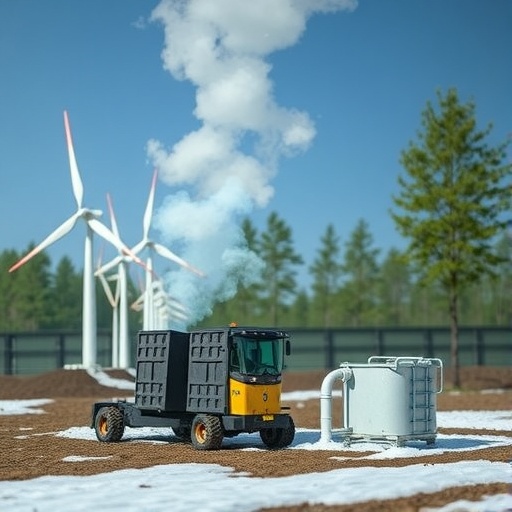Hydrogen fuel stands at the forefront of promising solutions to decarbonize the global economy due to its unique advantage of providing energy without emitting carbon dioxide. As the world intensifies efforts to curb greenhouse gas emissions, hydrogen’s potential as a clean energy carrier has garnered substantial attention from policymakers, industries, and researchers alike. The United States, accounting for roughly 10% of global hydrogen production, plays a pivotal role in this transition. However, not all hydrogen production methods contribute equally to emissions reduction — the environmental benefits hinge profoundly on the production pathway employed. Recent research led by the Yale School of the Environment sheds new light on the emergence of biomass-derived hydrogen (Bio-H2) as a compelling alternative to the conventional carbon-intensive hydrogen production processes.
Hydrogen is predominantly produced today via steam methane reforming, a process reliant on natural gas that releases significant amounts of carbon dioxide, thus undermining hydrogen’s environmental promise. Renewable alternatives, such as water electrolysis powered by sustainable electricity sources, are cleaner but face substantial technological and economic barriers. These include high capital expenditures, limited availability of suitable land, and substantial water resource demands. The landscape of hydrogen policy is further complicated by recent legislative adjustments in the U.S., such as the One Big Beautiful Bill Act passed in July, which phases out clean hydrogen production tax credits by 2027, disproportionately affecting electrolytic hydrogen production. These dynamic policy shifts underscore the urgency to explore near-term, cost-effective solutions like Bio-H2.
Bio-H2 production involves harnessing hydrogen from biomass sources, including energy crops such as switchgrass and miscanthus, alongside forestry and agricultural residues. This method leverages organic materials that would otherwise decompose or be burned, thereby reducing net carbon emissions. The Yale-led study employed an innovative analytical framework that integrates life cycle assessment (LCA) with the Global Change Analysis Model (GCAM), enabling a comprehensive examination of both supply and demand dimensions of hydrogen markets and policies over several decades. This approach allows for precise quantification of greenhouse gas mitigation potential across diverse hydrogen technologies within evolving market and climatic conditions.
Their findings revealed that although biomass-derived hydrogen typically emits more greenhouse gases than electrolytic hydrogen on a per-unit basis, it dramatically outperforms hydrogen produced from fossil fuels. In scenarios incorporating Bio-H2, the potential for carbon emissions reduction between 2025 and 2050 was found to be 1.6 to 2 times greater than in those excluding biomass routes. This suggests that integrating Bio-H2 into hydrogen supply chains could serve as a critical lever for accelerating decarbonization, especially in the near-term where the scalability of electrolysis remains challenged by cost and resource constraints.
The advocacy for Bio-H2 extends beyond emissions metrics. Using forest residues to produce hydrogen presents a dual benefit: it addresses the hazardous buildup of forest biomass that exacerbates wildfire risks while fostering a circular bioeconomy. This holistic environmental strategy aligns with sustainable land management practices, contributing to ecosystem resilience and carbon stock maintenance. Furthermore, leveraging agricultural waste streams prevents the wastage of valuable resources and offers rural economic development opportunities, potentially incentivizing participation in the hydrogen economy.
From a policy perspective, the study acknowledges the difficulty in implementing broad national carbon pricing in the U.S. in the near term. Instead, targeted incentives such as subsidies promoting hydrogen utilization in hardest-to-abate sectors like steelmaking could effectively stimulate demand. Sectoral subsidies can reduce hydrogen adoption costs and provide immediate climate benefits by replacing fossil-based inputs with cleaner hydrogen alternatives. This focused policy direction may yield faster emissions mitigation compared to generalized carbon pricing that lacks sector-specific nuance or practicality.
The study also highlights the distinct barriers facing water electrolysis-derived hydrogen. Electrolyzers require renewable electricity, which is still limited in capacity and infrastructure in many regions. Additionally, electrolytic hydrogen production demands significant freshwater resources and substantial capital investments, limiting feasibility for some markets. The upcoming removal of tax credits under the One Big Beautiful Bill Act threatens to slow investment momentum in this technology. As a result, Bio-H2 emerges as a complementary, scalable option capable of providing meaningful emissions reductions in the interim.
An intriguing contribution of the Yale team’s research lies in the integrative use of LCA combined with GCAM modeling to parse complex interactions between hydrogen supply chains, energy markets, and environmental outcomes. This methodological framework equips researchers and policymakers with nuanced insights into how emerging technologies can be optimally deployed. Such multidimensional analysis is essential for managing the trade-offs inherent in energy transitions, including balancing resource availability, economic viability, and climate imperatives.
In conclusion, the study underscores that achieving meaningful climate benefits through hydrogen demand and supply strategies requires a diversified portfolio that includes biomass-derived hydrogen. Near-term deployment of Bio-H2 offers a practical, lower-cost pathway to bridge the gap while electrolytic hydrogen technology matures and scales. Furthermore, instigating sector-specific incentives rather than relying solely on carbon pricing mechanisms may unlock faster adoption and deeper emissions cuts, especially within challenging industrial segments. Together, these pathways chart a more resilient and inclusive hydrogen-fueled decarbonization trajectory for the United States and potentially other hydrogen-producing regions globally.
As hydrogen’s role in the global energy matrix expands, it is essential that emerging policy frameworks, technological innovation, and market designs harmonize to exploit the full suite of low-carbon hydrogen production options. Biomass-derived hydrogen’s contribution to emissions mitigation, wildfire risk reduction, and circular bioeconomy promotion highlights its multifaceted significance. Future research leveraging advanced modeling tools, similar to the framework employed in this study, will be crucial to optimizing hydrogen deployment to meet ambitious climate goals.
The findings published in the Proceedings of the National Academy of Sciences on October 6, 2025, represent a pioneering step towards understanding and operationalizing hydrogen’s climate benefits in the United States. By illuminating the strategic importance of Bio-H2 alongside electrolytic production, the study provides a roadmap that stakeholders can follow to maximize the near- and long-term environmental returns on hydrogen investments. With sustained research and adaptive policies, hydrogen can transition from an emerging fuel to a cornerstone of a sustainable, low-carbon future.
Subject of Research: Hydrogen production methods, including biomass-derived hydrogen, and their climate mitigation potential in the United States.
Article Title: Supply–demand strategies for near-term climate benefits from hydrogen in the United States
News Publication Date: 6-Oct-2025
Web References: https://www.pnas.org/cgi/doi/10.1073/pnas.2519606122
Keywords: Environmental chemistry, hydrogen fuel, biomass hydrogen, electrolytic hydrogen, greenhouse gas mitigation, life cycle assessment, GCAM, circular bioeconomy, decarbonization strategies
Tags: biomass-derived hydrogencarbon emissions from natural gaschallenges in hydrogen technologyclean hydrogen productiondecarbonizing the global economyenvironmental impact of hydrogengreenhouse gas emissions reductionhydrogen fuel benefitshydrogen production pathwaysRenewable energy solutionssustainable energy policiesYale School of the Environment research






